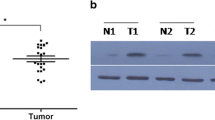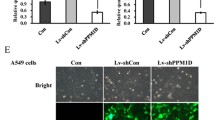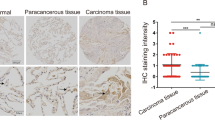Abstract
Lung cancer is the leading cause of cancer-related death in the world. Previous report has identified ribosomal protein s15a (RPS15A) as a TGF-β-responsible gene in the lung adenocarcinoma cell line A549. In this study, we used specific si-RNA to downregulate RPS15A expression in A549 cells and found that decreased RPS15A expression significantly inhibited cell proliferation and survival, as determined by 3-(4,5-dimethylthiazol-2-yl)-2,5-diphenyltetrazolium bromide and colony formation assays. Moreover, A549 cells were obviously accumulated in the G0/G1 phase in response to RPS15A knockdown, suggesting that RPS15A inhibition could induce a diminution of proliferation through cell cycle arrest. In addition, immunohistochemistry analysis further revealed that RPS15A was overexpressed in surgically resected lung cancer tissues. In conclusion, we identify RPS15A as a novel potential oncogenic gene involved in lung carcinogenesis. This study may provide a preliminary experimental basis for a gene therapy approach for treating lung cancer.






Similar content being viewed by others
References
Jimenez L, Becerra A, Landa A. Cloning, expression and partial characterization of a gene encoding the S15a ribosomal protein of Taenia solium. Parasitol Res. 2004;92(5):414–20.
Shen X et al. Scanning the human proteome for calmodulin-binding proteins. Proc Natl Acad Sci U S A. 2005;102(17):5969–74.
Bonham-Smith PC, Moloney MM. Nucleotide and protein sequences of a cytoplasmic ribosomal protein S15a gene from Arabidopsis thaliana. Plant Physiol. 1994;106(1):401–2.
Bonham-Smith PC, Oancia TL, Moloney MM. Cytoplasmic ribosomal protein S15a from Brassica napus: molecular cloning and developmental expression in mitotically active tissues. Plant Mol Biol. 1992;18(5):909–19.
Lavoie C et al. Suppression of a temperature-sensitive cdc33 mutation of yeast by a multicopy plasmid expressing a Drosophila ribosomal protein. J Biol Chem. 1994;269(20):14625–30.
Amsterdam A et al. Many ribosomal protein genes are cancer genes in zebrafish. PLoS Biol. 2004;2(5):E139.
Hannemann J et al. Classification of ductal carcinoma in situ by gene expression profiling. Breast Cancer Res. 2006;8(5):R61.
Coleman IM et al. Inhibition of androgen-independent prostate cancer by estrogenic compounds is associated with increased expression of immune-related genes. Neoplasia. 2006;8(10):862–78.
Lian Z et al. Human S15a expression is upregulated by hepatitis B virus X protein. Mol Carcinog. 2004;40(1):34–46.
Xu M et al. Down-regulation of ribosomal protein S15A mRNA with a short hairpin RNA inhibits human hepatic cancer cell growth in vitro. Gene. 2014;536(1):84–9.
Akiyama N et al. Identification of a series of transforming growth factor beta-responsive genes by retrovirus-mediated gene trap screening. Mol Cell Biol. 2000;20(9):3266–73.
Zhou H et al. Significance of semaphorin-3A and MMP-14 protein expression in non-small cell lung cancer. Oncol Lett. 2014;7(5):1395–400.
Travis WD et al. International Association for the Study of Lung Cancer/American Thoracic Society/European Respiratory Society International Multidisciplinary Classification of Lung Adenocarcinoma. J Thorac Oncol. 2011;6(2):244–85.
Siegel R, Naishadham D, Jemal A. Cancer statistics, 2012. CA Cancer J Clin. 2012;62(1):10–29.
Siegel R et al. Cancer treatment and survivorship statistics, 2012. CA Cancer J Clin. 2012;62(4):220–41.
Reungwetwattana T, Dy GK. Targeted therapies in development for non-small cell lung cancer. J Carcinog. 2013;12:22.
Yang X et al. Signal transducers and activators of transcription mediate fibroblast growth factor-induced vascular endothelial morphogenesis. Cancer Res. 2009;69(4):1668–77.
Laplante M, Sabatini DM. mTOR signaling in growth control and disease. Cell. 2012;149(2):274–93.
Smith AJ et al. Expression of the Bcl-2 protein BAD promotes prostate cancer growth. PLoS ONE. 2009;4(7):e6224.
Acknowledgments
This study was supported by the National Natural Science Foundation of China (no. 81401892).
Conflicts of interest
None
Author information
Authors and Affiliations
Corresponding author
Rights and permissions
About this article
Cite this article
Zhao, X., Shen, L., Feng, Y. et al. Decreased expression of RPS15A suppresses proliferation of lung cancer cells. Tumor Biol. 36, 6733–6740 (2015). https://doi.org/10.1007/s13277-015-3371-9
Received:
Accepted:
Published:
Issue Date:
DOI: https://doi.org/10.1007/s13277-015-3371-9




